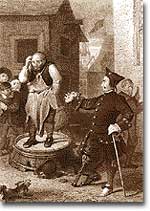4a. New Netherland to New York
England was not the first European power to settle the land known now as New York. That distinction belongs to the Dutch.

Governor Stuyvesant, appointed by the Dutch West India Company, told the colonists of New Netherland, "I shall govern you as a father his children."
Ironically, the English explorer Henry Hudson brought the region to the attention of the Netherlands in 1609 by sailing into New York Bay and up the river that would eventually bear his name.
New Netherland became a reality fourteen years later. The Dutch West India Company hoped to reap the profits of the area's fur trade.
Wait Just a Minuit
Shortly after setting up camp, Peter Minuit made one of the greatest real estate purchases in history. He traded trinkets (small ornaments, jewelry, etc.) with local Native Americans for Manhattan Island. The town that was established there was named New Amsterdam.
The Dutch had no patience for democratic institutions. The point of the colony was to enrich its stockholders.
The most famous governor of the colony, Peter Stuyvesant, ruled New Amsterdam with an iron fist. Slavery was common during the Dutch era, as the Dutch West India Company was one of the most prominent in the world's trade of slaves.
Languages that could be heard in the streets of New Amsterdam include Dutch, French, Flemish, Swedish, Danish, Finnish, and several other European and African tongues.
Northwest of New Amsterdam, New Netherland approached feudal conditions with the awarding of large tracts of land to wealthy investors. This would create eventual instability as the gap between the landed and the landless grew more obvious.
The British Are Coming
After Charles II came to the throne, the English became very interested in the Dutch holdings. In 1664, he granted the land to his brother, the Duke of York, before officially owning it.
When a powerful English military unit appeared in New Amsterdam, Governor Stuyvesant was forced to surrender and New Netherland became New York.
Santa Claus and Easter Eggs
Cultural contributions left by the Dutch include the pastimes of bowling and skating. Christmas and Easter were transformed by the introduction of Santa Claus and Easter eggs.
Any resident or visitor to Harlem or Brooklyn should recognize the Dutch influence in the names of locales. Although majority Dutch presence was short-lived, the legacy remains.






